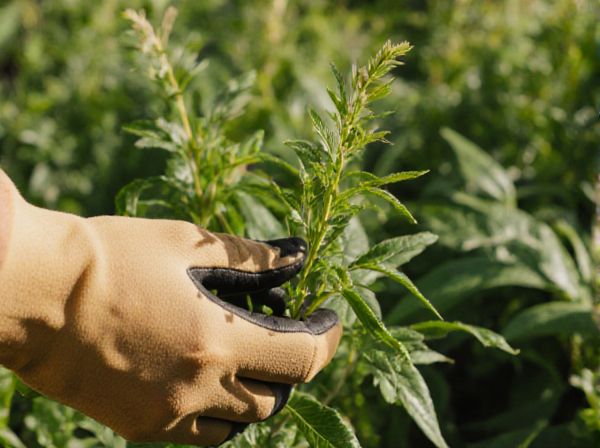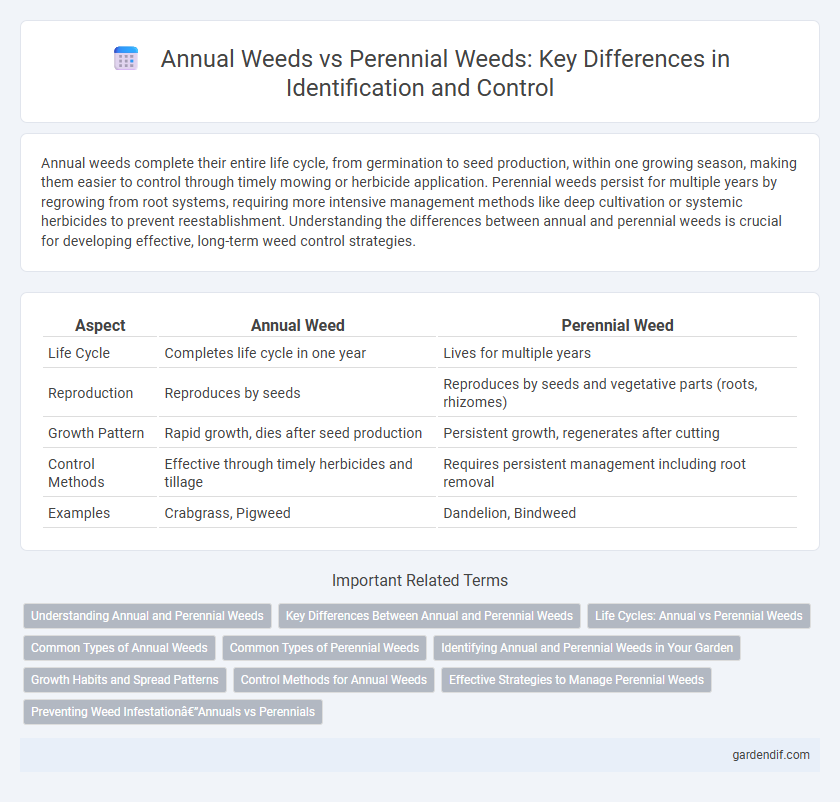
Annual weed vs Perennial weed Illustration
Annual weeds complete their entire life cycle, from germination to seed production, within one growing season, making them easier to control through timely mowing or herbicide application. Perennial weeds persist for multiple years by regrowing from root systems, requiring more intensive management methods like deep cultivation or systemic herbicides to prevent reestablishment. Understanding the differences between annual and perennial weeds is crucial for developing effective, long-term weed control strategies.
Table of Comparison
| Aspect | Annual Weed | Perennial Weed |
|---|---|---|
| Life Cycle | Completes life cycle in one year | Lives for multiple years |
| Reproduction | Reproduces by seeds | Reproduces by seeds and vegetative parts (roots, rhizomes) |
| Growth Pattern | Rapid growth, dies after seed production | Persistent growth, regenerates after cutting |
| Control Methods | Effective through timely herbicides and tillage | Requires persistent management including root removal |
| Examples | Crabgrass, Pigweed | Dandelion, Bindweed |
Understanding Annual and Perennial Weeds
Annual weeds complete their life cycle within one growing season, germinating, flowering, and dying within months, which leads to rapid seed production and spread. Perennial weeds persist for multiple years through deep root systems or underground structures like rhizomes and tubers, making them more difficult to eradicate. Effective weed management requires recognizing these growth patterns to tailor control methods such as timely mowing for annuals or root-targeted treatments for perennials.
Key Differences Between Annual and Perennial Weeds
Annual weeds complete their life cycle within one growing season, germinating, flowering, and dying, which requires control methods targeting seed prevention. Perennial weeds persist for multiple years through robust root systems or rhizomes, making physical removal or systemic herbicides more effective for long-term management. Understanding these differences is crucial for implementing appropriate weed control strategies and minimizing crop or garden damage.
Life Cycles: Annual vs Perennial Weeds
Annual weeds complete their life cycle within a single growing season, germinating, flowering, and dying in the same year, which requires rapid growth and seed production to ensure survival. Perennial weeds persist for multiple years through established root systems, enabling them to regrow after dormancy and making them more difficult to eradicate. Understanding the distinct life cycles of annual and perennial weeds is crucial for effective weed management strategies and control methods.
Common Types of Annual Weeds
Common types of annual weeds include pigweed (Amaranthus spp.), crabgrass (Digitaria spp.), and chickweed (Stellaria media), which complete their life cycle within one growing season. These fast-growing weeds produce abundant seeds that spread quickly, causing rapid infestations in gardens and agricultural fields. Effective management requires early identification and timely removal to prevent seed dispersal and reduce soil seed banks.
Common Types of Perennial Weeds
Perennial weeds, such as dandelions, bindweed, and creeping Charlie, pose persistent challenges due to their deep root systems and ability to regrow annually. These common types of perennial weeds thrive in various climates and soil conditions, making control difficult without targeted strategies. Effective management often requires a combination of mechanical removal and herbicidal treatments to prevent their extensive spread.
Identifying Annual and Perennial Weeds in Your Garden
Annual weeds complete their life cycle in one growing season, often characterized by fast germination, rapid growth, and abundant seed production, making them easier to control through timely removal before seeding. Perennial weeds survive for multiple years with established root systems, such as rhizomes or tubers, requiring persistent management strategies like deep root removal or systemic herbicides for effective control. Accurate identification based on life cycle traits, growth patterns, and root structure is crucial for implementing targeted weed control methods in your garden.
Growth Habits and Spread Patterns
Annual weeds complete their life cycle within one growing season, germinating, growing, reproducing, and dying in less than 12 months, which leads to rapid spread through prolific seed production. Perennial weeds persist for multiple years by developing extensive root systems or rhizomes, enabling vegetative reproduction and regrowth even after cutting or disturbance. Understanding these growth habits and spread patterns is crucial for effective weed management strategies targeting seed control in annuals and root system disruption in perennials.
Control Methods for Annual Weeds
Effective control methods for annual weeds combine cultural, mechanical, and chemical strategies to prevent seed production and soil seedbank replenishment. Mulching and timely cultivation disrupt weed emergence, while pre-emergent herbicides target germinating seedlings, reducing weed competition in crop systems. Consistent monitoring and integrated management promote long-term suppression of annual weed populations, minimizing impact on agricultural productivity.
Effective Strategies to Manage Perennial Weeds
Perennial weeds persist year after year due to their extensive root systems, making them more challenging to control than annual weeds that complete their life cycle in one growing season. Effective strategies for managing perennial weeds include consistent mechanical removal, such as repeated mowing or tilling, combined with targeted herbicide applications that disrupt root regrowth. Enhancing soil health and promoting competitive cover crops can suppress perennial weed establishment, reducing their impact over time.
Preventing Weed Infestation—Annuals vs Perennials
Preventing weed infestation requires distinct strategies for annual and perennial weeds due to their life cycles. Annual weeds complete their life cycle in one growing season, so timely soil cultivation and mulching can effectively disrupt seed germination. Perennial weeds regrow from established root systems, necessitating persistent removal and targeted herbicide applications to prevent long-term establishment and spread.
Annual weed vs Perennial weed Infographic

 gardendif.com
gardendif.com